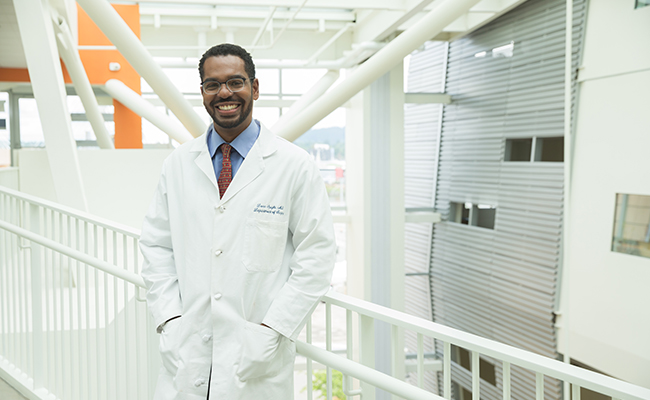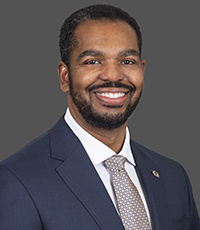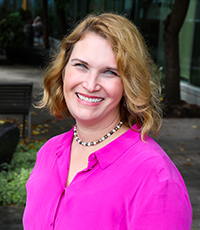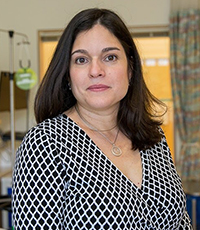OHSU Health Equity Organization

Oregon's population is growing and becoming more racially and ethnically diverse. There are many people in Oregon for whom English is not their primary language. However, some communities in our state have higher rates of good health than other communities.
Some Oregonians do not have the access they deserve to health care, food, income, housing and other resources. These shortages can lead to higher rates of illness and more severe health problems in certain communities, which we call "health disparities."
In January 2023, OHSU created the Health Equity Organization to:
- Provide equal access to health care
- Make sure all OHSU patients feel welcome
- Help every department at OHSU Health improve the quality of our care
Moving at the speed of trust

The OHSU Health Equity Organization is advancing how we deliver health care effectively and equitably — to all. It grew out of our COVID-19 pandemic response, in which we partnered with respected community leaders to reach those most harmed by the virus.
In moving at the speed of trust, something became clear: Systemic change can happen. It requires reimagining and rebuilding systems to make them work equitably.
We are not only building a system for health equity. We are striving to ingrain it into our culture — into the fabric of our collective identity — because it’s crucial to excellent, effective health care.
— Dr. Donn Spight, OHSU Vice President for Health Equity
Who we are
In 2022, OHSU named new leaders for the Health Equity Organization:

Donn Spight, M.D., Vice President for Health Equity

Kat Phillips, M.H.A., Senior Director of Health Equity Operations
In addition, a community advisory committee will guide our work. We are choosing 10 members who represent Oregon’s historically underserved communities. Members in these paid, nine-month roles make sure we see progress on their top priorities.
What is health equity?
Health equity means everyone has equal access to good health and excellent health care regardless of race, ethnicity, gender, ability, primary language, income, sexual orientation, gender identity, age and place of residence.
Read more about us
Learn more about how OHSU is advancing health equity and justice in our full report: Why Health Equity?
Questions?
Email us at healthequity@ohsu.edu
Leaders
- Donn Spight, M.D.
Vice President for Health Equity - Kat Philips, M.H.A.
Senior Director of Health Equity - Jeff Gold, M.D.
Director Health Disparities Reduction Core - Brian Park, M.D., M.P.H.
Medical Director and Director of Community Health Justice - Armando Jimenez, M.P.H., CPH
Director Language Services
A first for OHSU: Free health care services at Pride

Every year, the Portland Pride Waterfront Festival and Parade becomes more accessible. In 2024, we included access to free health care services in an affirming and inclusive experience. Read more.
Equitable Giving Circle clients can get produce and ‘ask a doc’

On Sept. 26, 2024, the Health Equity Organization launched a collaboration with Equitable Giving Circle. This Portland-based and Black women-led nonprofit organization aims to empower BIPOC (Black, Indigenous and People of Color) communities by shifting economic power. Read more.
About our work
The OHSU Health Equity Organization is taking steps to eliminate health disparities by:
- Listening to communities across Oregon so we can design programs together that improve access to health care
- Collecting and analyzing data to improve care for everyone
- Providing interpreters so every patient can communicate with health care staff in culturally appropriate ways
Quality improvement: To achieve health equity, we also formed the Health Disparities Reduction Core. This team helps us collect more data around who we are serving, who we are not serving, and the health outcomes that result from our care.
This data will be used to guide:
- How each department at OHSU delivers health care
- How we treat specific conditions
- How we spend our resources in communities across Oregon
- How we measure our progress
Common language: Respectful language puts our humanity at the center of the discussion. When we use a common language to talk about health equity, racism and justice, it helps everyone feel seen.
Working across OHSU
Achieving equitable access to health care is a team effort. In addition to the Health Equity Organization, several OHSU centers and programs are working toward health equity.
Reproductive health: In January 2023, the OHSU School of Medicine announced a Center for Reproductive Health Equity. The center, directed by Dr. Maria Rodriguez, advances reproductive health services, education and policy research.
Abortion access: Many states have sharply restricted access to abortion since the U.S. Supreme Court overturned Roe v. Wade in 2022. The restrictions put the most burden on people with low income and in marginalized communities. OHSU has extended abortion care to people from outside Oregon.
Virtual visits: OHSU is a telehealth leader after greatly increasing online appointments. Virtual visits save rural residents money and hours of travel.
Cancer clinical trials: Dr. Eneida Nemecek won a three-year grant in early 2023 to expand access to cancer clinical trials for people in rural and underserved communities. Clinical trials give patients a chance to try new therapies.
Community empowerment: The Health Equity and Leadership Inclusion eXperience (HEALIX) program empowers underserved communities through community organizing, leadership development and safe spaces. It is a partnership between OHSU's RELATE Lab’s Health Equity and Leadership at Richmond (HEAL-R) program and the OHSU Knight Cancer Institute.
Partnerships: To provide equal access to good health and excellent health care, the OHSU Health Equity Organization works with people across the OHSU Health system, including:
- Adventist Health Portland
- Center for Diversity, Equity, Inclusion and Belonging
- Center for Evidence-Based Policy
- Columbia Memorial Hospital
- Community Outreach, Research and Engagement
- Doernbecher Children’s Hospital
- Hillsboro Medical Center
- Language Services
- Office of Care Transformation and Innovation
- OHSU Health IDS
- OHSU School of Dentistry
- OHSU School of Medicine
- OHSU-PSU School of Public Health
- Oregon Office of Rural Health
- Patient Relations
- Transgender Health Program
Frequently asked questions
In the United States, we share a core belief in equality — treating everyone the same. Sometimes, however, that belief assumes that we all start out on equal footing. When we work toward equity, we recognize that each person or community faces unique barriers or advantages. We must address these imbalances to make sure everyone can achieve fair outcomes.
Health equity is our goal at our OHSU Health clinics: It means each of us has the opportunity to be as healthy as possible. To achieve this goal, we must make sure every person has access to the health care professionals, treatments and medicines they need.
A health outcome is the result of a medical condition that affects the length and quality of a person’s life. Health outcomes are driven by genetics, health behaviors, social and environmental factors. Research shows that Black mothers and babies have the worst childbirth outcomes in the U.S.
Disparities are differences in how a person or a group of people is treated. Health disparities are differences in health outcomes among racial, socioeconomic and other groups. They are unjust — and preventable. OHSU’s Health Equity Organization is exploring ways to address preventable differences within underserved communities. For example, studies have shown that Oregon health care workers are less likely to give pain medication to patients of color than to white patients.
Underserved communities are groups of people who experience discrimination and have been denied opportunities to participate in our economic, social and civic life. At OHSU, we are working to provide health equity to communities such as:
- African Americans and Black Americans
- Native Americans, including Native Alaskans
- Latino and Hispanic people
- Adults older than 65
- Rural Oregonians
- People whose first language is not English
- People who identify as lesbian, gay, bisexual, transgender and gender nonconforming
- People living under the federal poverty line
- People with disabilities
- People experiencing houselessness
- Refugees
- People involved in the justice system
- Veterans
Intersectionality refers to overlapping social identities — for example, an older Native American woman or a queer Latino person. Everyone has their own experiences of discrimination or privilege at the same time.
Racism means discriminating against a person, or treating them badly, based on their race or ethnic group. Racism causes emotional distress and trauma that can harm people and communities for generations.
Not all racism occurs in one-on-one interactions. Systemic racism, institutional racism and structural racism refer to laws and policies that create different outcomes for different racial groups:
- Systemic racism: For decades, banks and the real estate industry practiced "redlining." They outlined neighborhoods where home loan applicants were favored or denied based on race.
- Institutional racism: Denying someone a job or an educational opportunity based on their hair texture or style.
- Structural racism: Using voter suppression policies and laws to limit the political power of communities of color.
Questions? healthequity@ohsu.edu

